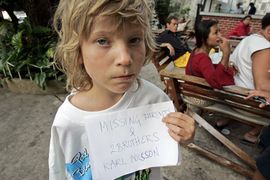| The waves have gone, what now? (this link is to a video clip that may be disturbing to sensitive viewers)
The social impacts of tsunami are enormous and, sadly, long term. In Samoa, a small island nation, hundreds of people were killed when a tsunami struck on 29 September 2009. Given the small population size of Samoa, the immediate effect of this event meant that in some cases generations of a family or even entire families were wiped out. Many Samoans living in New Zealand went to Samoa to help with the emergency response and relief efforts and to re-establish contact with family members.
Earlier in this course you heard from Abbey Wutzler and her family about how they felt when the tsunami hit Samoa while they were on holiday. Watch this news reel of interviews with American Samoans that survived the 2009 tsunami and with the family members that returned to help out. What impacts on the community can you see?
Many tourists were also killed, injured or stranded in Samoa and American Samoa afterwards. Some stayed to help when they could have returned to their own homes. In disasters such as tsunami, disaster relief carries on for a long time afterward to help rebuild and heal the societies affected. Although many countries provide relief to their neighbours in a disaster, the real lasting development happens inside the affected country. The strength of the government, the resilience of the local community and the local economy are the most important tools for regenerating communities after a disaster.
There are steps the community can take to minimise social impacts of a tsunami including:
- Identifying tsunami hazard areas and publicising these areas to the community and visitors to the area
- Identifying and promoting tsunami evacuation zones, routes, warning methods and signage
- Promoting and practicing evacuation procedures
|
|

